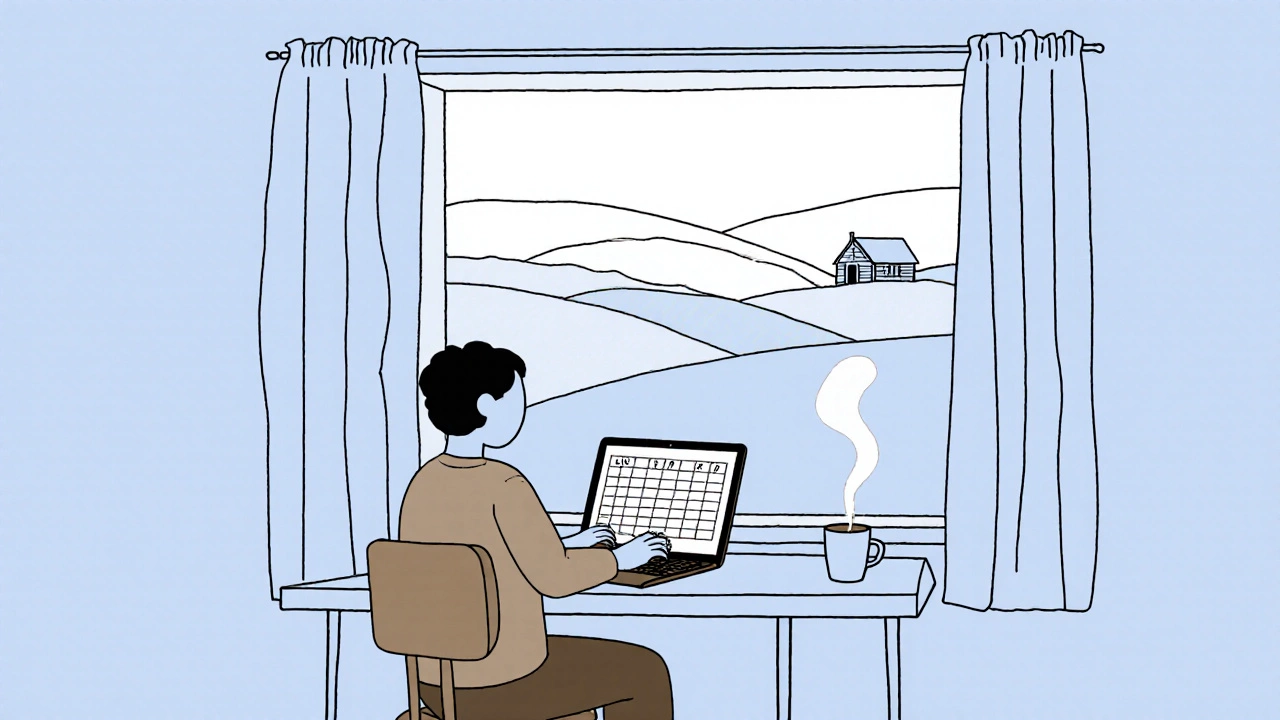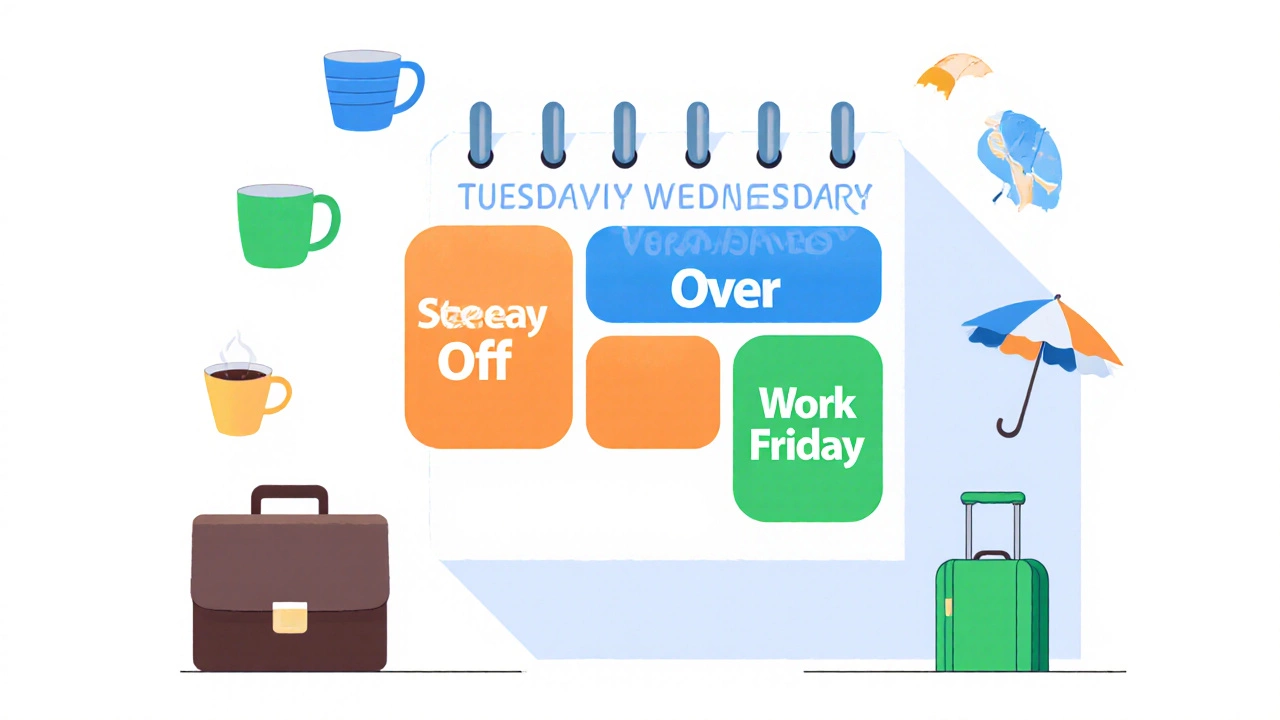2-2-2 Vacation Rule Planner
Plan Your Mini-Vacation
Enter a public holiday date to see how to apply the 2-2-2 rule. This creates a 4-day break using only 2 vacation days.
Result: You'll get a 4-day break using only 2 vacation days.
Key Takeaways
- The 2-2-2 rule means two days off, two work days, then two days off again.
- It converts ordinary weekdays into mini‑vacations without eating into annual leave.
- Applying the rule can boost mental health, productivity, and save money on travel.
- Plan ahead: pick a long weekend, swap shifts or use flexible hours, then book a short stay.
- Avoid common pitfalls like over‑booking or ignoring workplace policies.
Ever wondered why some friends seem to be out of the office every other weekend, yet they never run out of vacation days? The secret often lies in a clever scheduling hack called the 2-2-2 vacation rule is a short‑break strategy that strings together two days off, two work days, and another two days off. By timing your time‑off around existing long weekends, you can enjoy a series of mini‑getaways without draining your yearly leave balance.
What Exactly Is the 2-2-2 Vacation Rule?
At its core, the rule follows a simple pattern: 2‑2‑2. You take two consecutive days off, work the next two days, then take another two days off. The magic happens when you align the second set of two days with a public holiday or a scheduled weekend. This creates a four‑day stretch that feels like a proper vacation, while you only used two days of earned leave.
Imagine a standard Monday‑to‑Friday workweek. If a public holiday falls on a Thursday, you could:
- Take Tuesday and Wednesday off (first “2”).
- Work on Monday and Friday (the “2” in the middle).
- Enjoy Thursday (holiday) plus the following Friday as your second “2”.
The result is a four‑day break-Tuesday through Friday-while you only booked two vacation days.
Why It Works: The Science Behind Short Breaks
Research on work‑life balance shows that regular short breaks can lower stress hormones by up to 30% and improve focus when you return to work. A series of brief getaways also keeps the novelty factor high, preventing the burnout that often follows a single long vacation.
From a mental health perspective, a change of scenery resets your brain’s default mode network, helping you break out of routine thought patterns. This translates to better problem‑solving and creativity at work.
On the budget side, a short break strategy typically costs 40‑60% less than a week‑long trip, because you’re staying close to home and can often use budget-friendly accommodations like boutique B&Bs or Airbnb stays.

Step‑by‑Step Guide to Implement the 2-2-2 Rule
- Map the calendar. Look at the next 12 months and highlight all public holidays that create a three‑day weekend (e.g., Friday‑Sunday or Monday‑Wednesday).
- Identify swap opportunities. Talk to your manager about flexible hours or shift swaps for the two days you’ll need to work in the middle of the pattern.
- Reserve your leave. Submit a request for the two “off” days that flank the holiday. Because you’re only asking for two days, approvals are usually quick.
- Plan the getaway. Choose a destination that’s a 1‑2‑hour drive or train ride away-perfect for a weekend weekend getaway that doesn’t require a long‑haul flight.
- Budget smartly. Allocate a modest amount for lodging, meals, and activities. Use a travel budgeting worksheet to keep expenses under control.
- Unplug. Set an out‑of‑office message, turn off non‑essential notifications, and truly disconnect during your off days.
- Reflect and adjust. After each mini‑vacation, note what worked and what didn’t. Fine‑tune future trips for maximum relaxation and minimal hassle.
Real‑World Examples from Different Cities
Toronto: Use the Canada Day Monday holiday. Take Tuesday and Wednesday off, work Thursday and Friday, then enjoy the following Saturday-Sunday as part of your second “2”. A two‑night stay at Niagara Falls fits perfectly-short drive, budget‑friendly hotels, and plenty of attractions.
New York: Memorial Day falls on a Monday. Take Tuesday and Wednesday off, work Thursday and Friday, then use Thursday’s Thursday (well, the holiday) plus the weekend for a quick trip to the Catskills. Rental cabins cost around $150/night, a fraction of a summer resort price.
Berlin: The German Unity Day on October 3rd is a Tuesday. Work Monday, take Tuesday‑Wednesday off, then the holiday plus Thursday‑Friday becomes a four‑day break. A weekend in Leipzig by train (under €30 round‑trip) offers culture, food, and a change of pace without a big expense.
How the 2-2-2 Rule Stacks Up Against Other Vacation Strategies
| Strategy | Days of Leave Used | Typical Cost | Maximum Stretch | Ideal For |
|---|---|---|---|---|
| 2-2-2 Rule | 2 | Low (local travel) | 4days | Budget‑savvy professionals |
| 3‑1‑2 (Three days off, one work, two off) | 3 | Medium (short‑haul flights) | 5days | Those with flexible employers |
| Traditional Annual Leave | 5‑7 | Variable (depends on destination) | 7‑10days | Long‑haul travelers |
Notice how the 2-2-2 rule uses the fewest leave days while still delivering a four‑day break. It’s the most cost‑effective option for anyone who wants a regular rhythm of rest without draining paid time off.

Common Pitfalls & Pro Tips
- Pitfall: Forgetting to check workplace policies. Some companies have blackout periods around fiscal year‑end.
- Tip: Keep a master spreadsheet of holidays, approved swaps, and booked trips. It makes coordination with teammates painless.
- Pitfall: Over‑packing activities. A jam‑packed itinerary nullifies the relaxation benefit.
- Tip: Choose one or two “must‑do” experiences and leave the rest open for spontaneous wandering.
- Pitfall: Ignoring travel insurance for short trips. Even a weekend can encounter unexpected hiccups.
- Tip: A simple $10‑$15 travel‑insurance policy covers cancellations and medical emergencies for trips under three days.
Next Steps for Readers
If you’re ready to test the 2-2-2 rule, start by opening your calendar for the next six months. Highlight any public holidays that fall on a Monday or Thursday-those are your gold mines. Then pick one destination within a two‑hour radius and make a tentative reservation. The whole process should take less than an hour, and the payoff is a series of refreshing mini‑vacations that keep you energized all year long.
Frequently Asked Questions
Can I use the 2-2-2 rule if I only have flexible work hours?
Yes. Flexible hours actually make the rule easier. You can shift your two work days to the start or end of the week, then place the off days around a holiday. Just be sure your manager signs off on the adjusted schedule.
Does the rule work for companies that don’t offer public holidays?
Even without official holidays, you can create a 2‑2‑2 pattern by using two consecutive leave days, working two days, then taking the next two days off. It won’t be a four‑day stretch tied to a holiday, but you’ll still get two mini‑breaks in a row.
What’s the best destination for a 2‑day getaway?
Pick places within a 1‑2‑hour drive or train ride: nearby lakes, mountain towns, or cultural cities. The key is low travel time so you maximize relaxation. For Toronto residents, Niagara, Prince Edward County, or the Muskoka region are top picks.
How much can I expect to spend on a typical 2‑day weekend getaway?
A budget‑friendly trip usually ranges from $150 to $300 per person, covering accommodation, meals, and modest activities. Splitting costs with a partner or friends can bring the per‑person price down even further.
Will using the 2-2-2 rule affect my annual leave accrual?
No. The rule only uses two days of your paid leave per four‑day stretch. Your annual accrual continues as usual; you simply stretch the value of each leave day.
